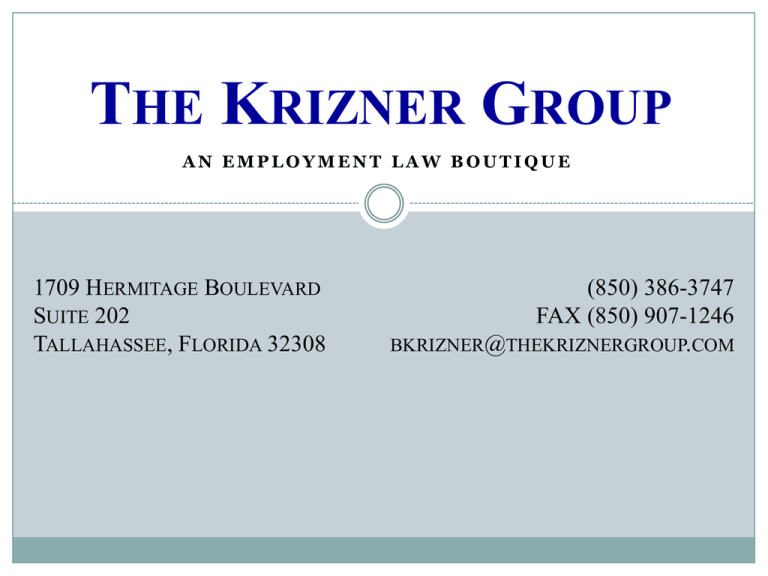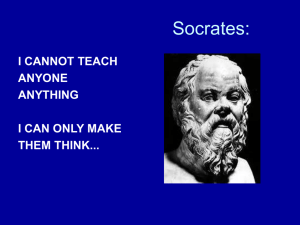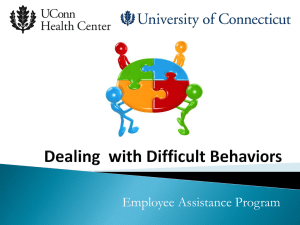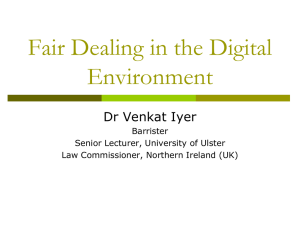The Krizner Group
advertisement

THE KRIZNER GROUP AN EMPLOYMENT LAW BOUTIQUE 1709 HERMITAGE BOULEVARD SUITE 202 TALLAHASSEE, FLORIDA 32308 (850) 386-3747 FAX (850) 907-1246 BKRIZNER@THEKRIZNERGROUP.COM LEADERSHIP: FROM MANAGER TO LEADER "Leadership is a function of knowing yourself, having a vision that is well communicated, building trust among colleagues, and taking effective action to realize your own leadership potential." -Warren Bennis LEADERSHIP: FROM MANAGER TO LEADER 1. What is YOUR mission? 2. How do you see such mission played out each day? 3. What role do you see yourself in your position contributing to this mission? LEADERSHIP: FROM MANAGER TO LEADER 1. True Organizational Leadership is: A) The position or office of authority B) The capacity or ability to lead C) To guide or direct in a course; to inspire the conduct of D) To play a principal role in leading 2. I sincerely spend ______% of my working hours communicating with and overseeing my employee’s performance. LEADERSHIP: FROM MANAGER TO LEADER 3. The best way to deny an employee’s request is: A) Recognize the reason for the request and provide a mission based rationale for the denial B) Suggest that you will run the request by your supervisor and then get back with the employee C) You should never completely deny an employee’s request 4. A true leader knows when people need supervision when: A) They ask for it B) An error, delay, or problem occurs C) An employee approaches you on another matter but mentions the issue or project of concern in a tangential manner D) All of the above LEADERSHIP: FROM MANAGER TO LEADER 5. A leader should A) Recognize the human needs of their employees to build teamwork, assist with their problems, and provide psychological support B) Continue to provide all of their employees with new and challenging goals for improvement and continuing areas of growth C) Utilize rewards such as education, additional independence, and money to motivate employees’ performance D) All of the above 6. An effective leader only employs one type of management style to all situations. True________ False__________ LEADERSHIP: FROM MANAGER TO LEADER WHAT DOES A LEADER LOOK LIKE? 10 TRAITS OF TRUE LEADERSHIP 10 TRAITS OF A TRUE LEADER #1 The Capacity To Create Or Catch Vision Describe the last time that you believe you caught a vision for the Agency’s betterment. #2 Embraces The Thrill Of A Challenge What current challenge are you facing now that will further the Agency’s mission? #3 A Constructive Spirit Of Discontent When was the last time that you asked “Have you ever thought about what the better way to do this task might be?” 10 TRAITS OF A TRUE LEADER #4 A Strong Distaste For Status Quo What stronghold currently within your authority needs to be broken? #5 A Willingness To Take Responsibility For Failures When was the last time that you made a publicly recognized mistake? #6 A Completion Factor. How many projects or goals that you set last year are still incomplete? #7 A Mental Toughness Have you felt lonely at work in recent months? 10 TRAITS OF A TRUE LEADER #8 Respect From Peers What is your relationship with your fellow leaders – are they encouraging your success? #9 An Approachability Factor With Employees How often do your employees approach you with issues or concerns? #10 Immense Strength Of Character Describe the last time that you made the “right” decision that resulted in the wrong consequences. LEADERSHIP: FROM MANAGER TO LEADER THREE PRIMARY LEADERSHIP STYLES I. Authoritarian II. Participative/Democratic III. Delegative THREE PRIMARY LEADERSHIP STYLES I. Authoritarian A. Defined: State what you want done and how you want it done without advice of employee. B. Strengths: Efficient; Easy C. Weaknesses: Potential For Tyrannical Perception D. Best Use: When you possess all the information to solve the problem; you are short on time; your employee(s) is motivated THREE PRIMARY LEADERSHIP STYLES II. Participative/Democratic A. Defined: Include one or more employees in decision making process, but you make final decision. B. Strengths: Creative Addition; Empowering C. Weaknesses: Time Consuming; Negative Morale When Alternative Decision Is Selected; Need Skillful Employees D. Best Use: When you possess part of the information to solve the Problem and your employees possess part of the information; need for “buy in” exists. THREE PRIMARY LEADERSHIP STYLES III. Delegative A. Defined: Allow the employee(s) to make the decision, but you remain wholly accountable for decision. B. Strengths: Very Empowering; Utilize Skill Of Team; Efficient C. Weaknesses: Personal Risk; Potential Usurping Of Leadership Authority D. Best Use: When you have full confidence in employee’s knowledge and discretion; issue falls outside your area of expertise LEADERSHIP: FROM MANAGER TO LEADER WHICH LEADERSHIP STYLE SHOULD BE USED IF… FOUR SCENARIOS LEADERSHIP: FROM MANAGER TO LEADER Scenario One: A new employee begins to improperly communicate with a client and another employee alerts you to the seriousness of the situation. Preferred Leadership Style: _____________________________________ LEADERSHIP: FROM MANAGER TO LEADER Scenario Two: You learn that a new funding requirement has been issued that impacts the manner in which your team provides service to the Agency’s clients. Preferred Leadership Style: _____________________________________ LEADERSHIP: FROM MANAGER TO LEADER Scenario Three: A senior employee approaches you with an issue involving one of her clients and believes that an unusual course of action is necessary. Preferred Leadership Style: _____________________________________ LEADERSHIP: FROM MANAGER TO LEADER Scenario Four: There continues to be a breakdown in the Paid Time Off policy in place within the Agency and several employee teams find that it is not working within their work areas. Preferred Leadership Style: _____________________________________ DEALING WITH DIFFICULT EMPLOYEES & CONFLICT DEALING WITH DIFFICULT EMPLOYEES & CONFLICT HOW TO HANDLE EVERY CONFLICT Step 1: Define The Problem Step 2: Define Your Employee(s) 1 of 7 Personality Types Step 3: Establish Your Relationship To The Employee(s) Step 4: Define The Employee(s)’ Subjective Position Step 5: Identify The Objectively Correct Position DEALING WITH DIFFICULT EMPLOYEES & CONFLICT HOW TO HANDLE EVERY CONFLICT Step 6: Mediate With The Employee(s) By Comparing Step 4 vs. Step 5 Phase A: Recognize The Correct Points In Employee(s)’ Position Phase B: Identify The Deficiencies In Employee(s)’ Position • Written Policy/Practice • Verbal Policy/Practice • Best Interest Of Agency • Authority Of Supervisor Phase C: Set Forth The Corrective Plan For Employee • Based On Authority Above • In Writing Phase D: Require Employee(s) To Buy Into Resolution • Allow To Verbalize • Go Back To Authority Above – Require DEALING WITH DIFFICULT EMPLOYEES & CONFLICT HOW TO HANDLE EVERY CONFLICT + DETRACTORS: (1) Timing Of Mediation (2) Prior Practices With Employee or Situation (3) Emotions Of Employee(s) Personality Clash: Supervisor VS. Employee Step 7: Business As Normal OR Separation DEALING WITH DIFFICULT EMPLOYEES & CONFLICT PERFECTIONIST “I AM RIGHT AND YOU ARE NOT!” Strengths: (1) Organization (2) Detail (3) High Ethics Ideal Job: Fiscal Officer Workplace Difficulties: (1) Critical Of Others (2) Rigid In Approach (3) Withhold Information DEALING WITH DIFFICULT EMPLOYEES & CONFLICT PERFECTIONIST “I AM RIGHT AND YOU ARE NOT!” Preventative Solutions: Do Not Rush Corrective Solutions: (1) One-on-One Honest Discussions (2) Emphasize Others Faults DEALING WITH DIFFICULT EMPLOYEES & CONFLICT HELPER “YOU DON’T APPRECIATE ME!” Strengths: (1) Generous (2) Willing (3) Empathetic Ideal Job: Assistant Workplace Difficulties: (1) Off Task (2) Fearful (3) Emotional DEALING WITH DIFFICULT EMPLOYEES & CONFLICT HELPER “YOU DON’T APPRECIATE ME!” Preventative Solutions: Constant Appreciation Corrective Solutions: (1) Sit with other supervisors to discuss workload (2) Review priorities DEALING WITH DIFFICULT EMPLOYEES & CONFLICT ACHIEVER “IT WASN’T MY FAULT” “IT WORKED OUT JUST FINE” Strengths: (1) Confident (2) Get The Job Done! (3) Productive Ideal Job: Executive Director/CEO Workplace Difficulties: (1) Not accept criticism (2) Rationalize failure (3) Dislike of indecisive people DEALING WITH DIFFICULT EMPLOYEES & CONFLICT ACHIEVER “IT WASN’T MY FAULT” “IT WORKED OUT JUST FINE” Preventative Solutions: Use hard criteria to evaluate success Corrective Solutions: (1) Emphasize strength of others and their purpose (2) Force to see human element/feelings DEALING WITH DIFFICULT EMPLOYEES & CONFLICT ARTIST “I THOUGHT THEY HAD IT HANDLED.” Strengths: (1) Passionate (2) Provides New Ideas (3) Creative Ideal Job: Public Relations; Graphic Design Workplace Difficulties: (1) Emotional (2) Uncommitted (3) Opinionated DEALING WITH DIFFICULT EMPLOYEES & CONFLICT ARTIST “I THOUGHT THEY HAD IT HANDLED.” Preventative Solutions: Take time to get to know them personally Corrective Solutions: (1) Emphasize value of creativity (2) Soft counseling highlighting positives DEALING WITH DIFFICULT EMPLOYEES & CONFLICT QUIET “JUST LEAVE ME ALONE!” Strengths: (1) Productive (2) Quiet (3) Thoughtful Ideal Job: Any job not requiring extensive interaction with others Workplace Difficulties: (1) Bothered (2) Quiet (3) Cannot Accept Change DEALING WITH DIFFICULT EMPLOYEES & CONFLICT QUIET “JUST LEAVE ME ALONE!” Preventative Solutions: Don’t place in spotlight Corrective Solutions: (1) Plan to remove from conflict (2) Use mediator DEALING WITH DIFFICULT EMPLOYEES & CONFLICT SKEPTIC “I JUST DON’T THINK THIS WILL WORK…” Strengths: (1) Challenges Norms (2) Loyal Ideal Job: The “#2” Job Workplace Difficulties: (1) Sarcasm (2) Doubter (3) Deference to underdog DEALING WITH DIFFICULT EMPLOYEES & CONFLICT SKEPTIC “I JUST DON’T THINK THIS WILL WORK…” Preventative Solutions: Recognize value in second opinion, but don’t rely on it Corrective Solutions: (1) Use strength to put skeptic into place (2) Show weakness of second position, strengths to first DEALING WITH DIFFICULT EMPLOYEES & CONFLICT SOCIAL “I’LL CALL YOU TOMORROW ON THAT ONE…” Strengths: (1) Energizer (2) Natural Charisma (3) Optimistic Ideal Job: Counselor; Salesperson Workplace Difficulties: (1) Ignores problems (2) Outtalks supervisors DEALING WITH DIFFICULT EMPLOYEES & CONFLICT SOCIAL “I’LL CALL YOU TOMORROW ON THAT ONE…” Preventative Solutions: (1) Monitor with hard goals (2) Do not allow to supervise others Corrective Solutions: (1) Remove from problem (2) Put in writing (3) Change to reward basis DEALING WITH DIFFICULT EMPLOYEES & CONFLICT THE STORY OF BOB & AMY: CAN’T WE ALL JUST GET ALONG?!? Bob is the senior supervisor in his department and has held his same position for twenty (20) years. Despite some reluctance based on Bob’s promiscuous reputation, Amy recently agreed to a transfer to work with Bob. She is the proverbial “prodigy” employee that the organization treasures. Bob has heard about Amy’s work ethic and insistence on controlling everything she touches. The department has recently been assigned the tedious task of reorganizing the organization’s records, research, and data. It has historically been kept in a warehouse in cardboard boxes and the only organization has been marker notations scribbled on the sides of each box. DEALING WITH DIFFICULT EMPLOYEES & CONFLICT THE STORY OF BOB & AMY: CAN’T WE ALL JUST GET ALONG?!? After announcing the new assignment to the department, Bob explains that he is open to suggestions on the methodology of organizing this mass amount of information. Amy strongly states “no question about it - the only way to go is electronic.” She then explains that the paper information will be scanned into the computer system, then organized utilizing data collection software, and finally destroyed. Bob scoffs at the comment and quips that such a concept would take entirely too long to implement and would be vulnerable on a computerized system. He suggests that there are too many other projects that need his employees’ attention. Bob also thinks to himself that he only has two more years until his retirement and this new assignment is the last thing that he needs. Bob then announces that two employees will be assigned to sort through the boxes and file the documents into specified folders to create a more organized system than the one currently in place. DEALING WITH DIFFICULT EMPLOYEES & CONFLICT THE STORY OF BOB & AMY: CAN’T WE ALL JUST GET ALONG?!? Amy jumps to her feet, slams her fist to the table, and retorts, “you are an absolute control freak – everyone agrees that computerized information is the way of the future.” She then walks out the door and slams her door as she walks into her office. Bob also leaves the meeting and locks himself into his office. NOW WHAT??? DEALING WITH DIFFICULT EMPLOYEES & CONFLICT THE 10 STEPS THAT ARE SURE TO RESOLVE ANY ISSUE CONFLICT #1 Define the issue clearly. What is it about? Write the issue in question form. #2 Know the goal you are attempting to achieve. Does your position truly further the overall goal or another unrelated goal? Write down the goal and describe how your position accomplishes that goal. #3 Are your personal feelings interfering with the resolution? Separate personal feelings from issue. Write down any personal feelings that you have toward the other person. DEALING WITH DIFFICULT EMPLOYEES & CONFLICT THE 10 STEPS THAT ARE SURE TO RESOLVE ANY ISSUE CONFLICT #4 What are the relevant existing facts? Give the facts (or get them!), avoid opinion. Objectively write down the known facts surrounding the issue. #5 What parts of the other person’s position do you agree with? Identify where you agree – find the common ground. Write down the areas in which you and the other person agree. In addition, write down the areas in which you disagree. #6 Identify where you can afford to lose and admit those areas to the other person. Most issues have several points – weigh the true cost of “losing” your position. Place a check mark by those areas of your position that are “losable.” DEALING WITH DIFFICULT EMPLOYEES & CONFLICT THE 10 STEPS THAT ARE SURE TO RESOLVE ANY ISSUE CONFLICT #7 Separate your personal feelings from issue – AGAIN. Step 6 is where most people falter – can you overcome it? Go back and revisit your notes from #3. #8 Create wholly 3rd position solutions with wiggle room. Assume that your position and the other person’s position are both theoretically impossible, what third options are available? Write all possible solutions down. Do they incorporate some of both parties’ positions? #9 Engage in an interactive resolution process. Remember the wiggle room from step number 8? Remember that all successful resolutions include losing positions on both sides. #10 Apologize & Forgive!







